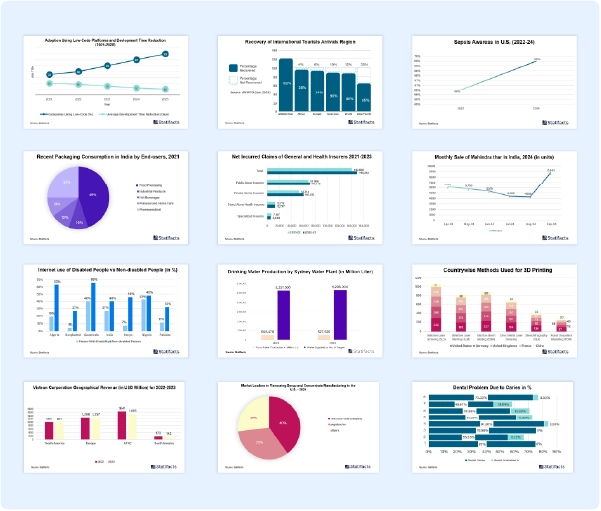The U.S. cell culture media market size was exhibited at USD 2,319 million in 2024 and is projected to hit around USD 6,561 million by 2034, growing at a CAGR of 10.96% during the forecast period 2024 to 2034.
U.S. Cell Culture Media Market Report Highlights
- The serum-free media segment held the largest U.S. cell culture media market share of 37.20% in 2024.
- The stem cell culture media segment is expected to grow significantly during the forecast period.
- The biopharmaceutical production segment registered the highest revenue share of 49.10% in 2024.
- The diagnostics segment is expected to witness a considerable CAGR during the forecast period.
- The liquid media segment witnessed the highest revenue share of 69.2% in 2024.
- The semi-solid and solid media segment is expected to grow at a significant CAGR during the forecast period.
- The pharmaceutical & biotechnology companies segment captured the highest revenue share of 39.91% in 2024.
- The hospital and diagnostic laboratories segment is projected to grow at a significant CAGR during the forecast period.
The U.S. cell culture media market refers to the production, distribution, and use of cell culture media, which is also known as growth media. It is an umbrella term that includes any gel or liquid created to support cellular growth in an artificial environment. Cell culture media usually consists of a source of energy and other compounds used to regulate cell cycles. A typical cell culture medium is made of a complement of inorganic salts, glucose, vitamins, serum, and amino acids as a source of hormones, growth factors, and attachment factors. Culture media is a liquid or gel that contains nutrients, and it is used to grow microorganisms or bacteria. Components in cell culture media supply your culture environment with nutrients and growth factors for the cells to behave as expected. Additionally, media can be formulated to regulate experimental conditions in cell culture, including pH and osmotic pressure.
The applicability of regenerative medicine and tissue engineering has increased the demand for cell culture media. In tissue engineering applications, cells are cultured on a nanofiber scaffold to prepare a cell-based scaffold and promote its bioactivity. The cell-based scaffold is used to allow the fabrication of functional tissues or organs, which can be used for reparative procedures in patients and contribute to the growth of the U.S. cell culture media market. Tissue engineering approaches can be used to repair defects in articular cartilage and restore joint functions. Regenerative medicine therapies include isolating and growing cells and manipulating them if needed, which are then transplanted into the body to exert therapeutic effects against entities to which endogenous ligands or drugs bind, which results in a changed behavior pattern or function. It may also support the repair and regeneration of injured tissue through differentiation and the trophic effect. Regenerative medicine is a cell-based treatment that may regrow cartilage, tendons, and other tissues. This can provide relief for conditions like degenerative disc disease in spines, chronic tendonitis, and osteoarthritis.
Increased investment in stem cell research helps the growth of the U.S. cell culture media market. Stem cell culture media are specially designed to support proliferation, differentiation, cryopreservation, and growth of stem cells. Clinical applications of stem cells include treatment for cardiovascular and neurological diseases, wound healing, cancer, autoimmune disorders, and disease molding and drug screening. Stem cell research is studied to treat heart failure, amyotrophic natural sclerosis, Parkinson’s disease, Type 1 diabetes, and other conditions. Stem cells have the potential to grow new tissues for use in transplant and regenerative medicine.
Increased research and development expenditure in many areas, like stem cell research, oncology, genetic disorders, and neuroscience, is advantageous to the U.S. cell culture media market. Cell culture media play an essential role in growing naturally occurring cells outside their environments for industrial and research applications. These nutrient-rich solutions support cell growth by supplying essential hormones, nutrients, and growth factors. In modern biomedical research, cell culture media plays an important role. Cell culture has transformed and become a fundamental part of biomedical research. Its scalability and versatility cater to diverse needs, advancing medicine, exploring new therapies, modeling diseases, and investigating cellular mechanisms.
Artificial intelligence (AI) makes the optimization of cell culture media easier. Cell culture media is an important technology used in regenerative medicine and pharmaceutical production. By using artificial intelligence (AI) based automation and decision-making, researchers can make cell culture processes fully autonomous or adopt a co-piloted approach. This helps in the standardization of procedures and also ensures reproducibility and consistency across 2D and 3D cell culture workflows. Bringing in AI and automation can enhance every step of cell culturing, leading to enhanced efficiency in research and drug development. AI also makes protocol development more efficient. AI can help to develop culture by reducing associated labor. These factors contribute to the growth of the U.S. cell culture media market.
Published by
Laxmi Narayan

